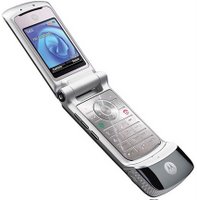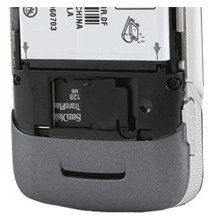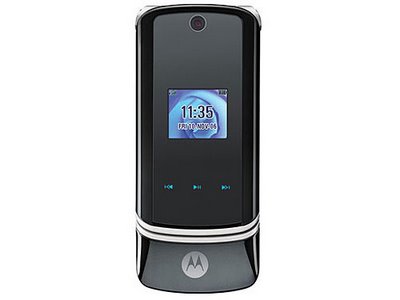 Just when you thought Motorola couldn't ride the wave from its popular Razr any longer, the once-staid, now-cool company rolls out its line of Krzr handsets. Styled similar to the Razr but with a few important improvements, the Motorola Krzr K1m casts a slim and striking profile that's sure to send cell phone fashionistas into a tizzy. As with its predecessor, the style-focused form factor entails some usability sacrifices in the controls, but the Krzr K1m ranks as the one of the prettiest cell phones we've seen thus far. On the downside, performance had its high and low points, and the Krzr K1m's features set, which includes Bluetooth, a megapixel camera, and support for EV-DO networks, doesn't offer any changes over Razr V3m. And in all seriousness, just where did Motorola get the silly name? (There's also a GSM version of the phone, the Krzr K1).
Just when you thought Motorola couldn't ride the wave from its popular Razr any longer, the once-staid, now-cool company rolls out its line of Krzr handsets. Styled similar to the Razr but with a few important improvements, the Motorola Krzr K1m casts a slim and striking profile that's sure to send cell phone fashionistas into a tizzy. As with its predecessor, the style-focused form factor entails some usability sacrifices in the controls, but the Krzr K1m ranks as the one of the prettiest cell phones we've seen thus far. On the downside, performance had its high and low points, and the Krzr K1m's features set, which includes Bluetooth, a megapixel camera, and support for EV-DO networks, doesn't offer any changes over Razr V3m. And in all seriousness, just where did Motorola get the silly name? (There's also a GSM version of the phone, the Krzr K1). While we don't hide the fact that we're growing tired of the thin-phone phenomenon, we'll admit readily that the Krzr is getting us excited about diet handsets all over again. To put it mildly, the Krzr K1m is very pretty, so pretty that it makes the Razr look like some circa-1980s car phone. While the Razr was a one-trick pony with its design--thin from the side, yes, but also boxy and plain from the front--the Krzr is beautiful all around. At 4.05 by 1.73 by 0.67 inches, it has a slightly thicker profile than the Razr while also being taller and thinner when measured across its front face. The dimensions make the Krzr much more comfortable to hold in the hand and it feels better when cradled against your face. Also, at 3.6 ounces (a tad more than the Razr's 3.3 ounces), it enjoys a more solid construction and a sturdier hinge. It's still a bit hard, however, to feel such a small phone vibrate when it's in your pocket.
As Moto is quick to point out, the Krzr includes a plate of hardened reflective glass on its front face. Though that sounded a bit gimmicky when we first heard about it, the result is undeniably appealing with a sleek and sharp look. The dark gray color is nice as well, though we're partial to the blue face on the GSM Krzr K1. On the other hand, the K1m's darker hue attracts fewer smudges and fingerprints than the K1m. Motorola promises the glass will withstand cracking and scratches, but we didn't try to prove that wrong. Another highlight was the shiny chrome plating on the handset's bottom end.
The postage stamp external display is a bit small for the phone's size, but it shows an acceptable 65,536 colors. You can view the date, time, signal strength, battery life, and caller ID (where available), and you can use the display as a viewfinder for self-portraits. The display disappears entirely when the backlighting is off, but a flick of any exterior button will activate it again. Alternatively, you can change the backlighting time to always-on.
The camera lens lies above the display, though it's disappointing that yet again there's no flash. On the upside, however, one of the phone's more interesting design features sits just below the display near the bottom of the front flap. Here are three touch-sensitive buttons for controlling the music player. Fortunately they are lit and usable only when the player is on--a wise design decision, as it's impossible to activate the player accidentally--but they can be too sensitive when the player is on. We paused out music unintentionally a few times, which was annoying. Overall, however, we'd favor the Krzr's touch controls above those on the LG Chocolate.
Completing the outside of the phone is a voice-dialing button on the left spine and a volume rocker and speakerphone/smart key on the left spine. A covered mini USB port sits on the left spine as well, but it's worth noting that, because it's the port for both the headset and the charger, you can use only one accessory at a time. The Micro SD card slot is located somewhat inconveniently behind the battery cover. We're glad you don't have to remove the battery as well, but we'd prefer to find it on the outside of the handset.

The Krzr K1m's memory slot is hidden behind the battery cover.
The Krzr's internal display measures a roomy 1.9 inches (176x220 pixels) and supports 65,536 colors. The result is a rich and vibrant screen that displays most anything well. You can change the backlighting time and the brightness, but no other options are customizable.
The navigation array and keypad buttons will look familiar to Razr fans; they have a similar design and layout. The four-way toggle doubles as a shortcut to four user-defined functions, while the OK button in the toggle's center opens the menu when in standby mode. Surrounding the toggle are two soft keys, a dedicated shortcut, a Clear/Back key and the traditional Talk and End/Power controls. Though the navigation array as a whole is smaller than on the Razr (due to the Krzr's smaller size), it's still spacious enough for users with big paws. Keypad buttons are a holdover from the Razr as well, with a flat design and no separation between the individual buttons. They have a bit less texture than on some of the newer Razrs (such as the V3i), so it's harder to dial by feel, and the keys can be slippery and difficult to master. On the other hand, they are brightly backlit.
We admit we've just spent a lot of time taking about the Krzr's design, but look and feel are really what the phone is all about. As we said previously, it doesn't offer anything new in terms of features, so there's a lot less to talk about in that department. There's a 1,000-contact phone book with room in each entry for five phone numbers and two e-mail addresses. You can organize contacts into groups or pair them with a photo or one of 20 (72-chord) polyphonic ring tones for caller ID. Basic features include a vibrate mode, a voice recorder, text and multimedia messaging, an alarm clock, a calendar, a calculator, a notepad, a world clock, and a notepad. On the higher end, there's a speakerphone, voice dialing and commands, a mini USB port, e-mail, and PC syncing. Bluetooth is onboard as well, but its options are limited. Though you still can't use it to transfer music files and ring tones, in a welcome move toward customer-friendliness Verizon is now offering photo transfers via that feature. Onboard usable memory is a bit skimpy at 18MB, but the Micro SD card slot gives you even more room.
In a strange move, the K1m's camera is 1.3-megapixel, while the GSM Krzr K1 offers a 2-megapixel shooter. We're scratching our heads at the disparity, which doesn't make a whole lot of sense. Nonetheless the K1m's camera does the job. You can take pictures in four resolutions (1,280x1,024; 640x80; 320x240; and 160x120) but you don't get a selection of quality settings. Other options include a multishot option, brightness and white-balance controls, a self-timer, three color effects, an 8X zoom, 10 fun frames, and three shutter sounds (plus a silent option).The camcorder shoots clips in 176x144 resolution with sound; editing options are similar to the still camera. Videos meant for multimedia messages are capped at 14 seconds; otherwise you can shoot for as long as the available memory permits. Image quality was decent but not quite what we expected from a megapixel camera. Images were bit blurry, and colors weren't always sharp.
As an EV-DO phone, the Krzr K1m supports the full range of Verizon's 3G services including the V Cast video service and the V Cast music store. The music player's interface is standard for all phones from the carrier that support the music store. You also get access to a variety of Verizon applications including VZ Navigator, Backup Assistance, and Chaperone as well as a host of alternative programs and services such as Fox Sports Mobile Pro, Extra TV, and Weathernews. There isn't much for gamers; you get demo versions of just two titles (Tetris and Pac-Man). Full versions and other games are available for purchase with the WAP 2.0 wireless Web browser. Just remember that Verizon uses BREW instead of Java. You can personalize the Krzr K1m with a variety of wallpapers, screensavers, and sounds. You can always buy more choices if you want them.
We tested the (CDMA 800/1900; EV-DO) Motorola Krzr K1m in San Francisco using Verizon's service. Sound quality was unchanged from other Verizon phones like the V3m. Voices were clear, and volume actually was a bit louder than most of the Razrs we've tried. On their end, callers said we sounded fine, and they could hear us plainly in louder environments. At times there was a slight hiss in the background, but it wasn't bothersome. Reception was sharp, and the EV-DO connection was strong even in buildings. Speakerphone calls sounded a bit hollow but with enough volume, and Bluetooth headset calls were satisfactory.
Music audio quality was decent, though the hiss that was audible during phone calls seemed louder here. It didn't make our tunes intolerable by any means, but it did give them a robotic and bass-heavy effect. The music player itself was sluggish at times, and it often paused for a few seconds when navigating though different options. Also, unless you set it as a shortcut through the navigation toggle, it took too many clicks to activate the player. A 2.6MB song took about a minute and 30 seconds to download, which is rather slow. V Cast video also was unimpressive. It took up to a minute to access the application's main menu and navigation through menus was sluggish here as well. What's more, clips showed a fair amount of pixilation. If you're a multimedia nut, Verizon has better, but less-pretty options such as the LG VX8300.
The Motorola Krzr K1m has a rated talk time of 4.2 hours and a promised standby time of 18 days. In our tests, we managed to get a talk time of 4 hours and 16 minutes. According to FCC radiation tests the Krzr K1m has a digital SAR rating of 1.03 watts per kilogram.


 Add to Favorites
Add to Favorites
0 comments: